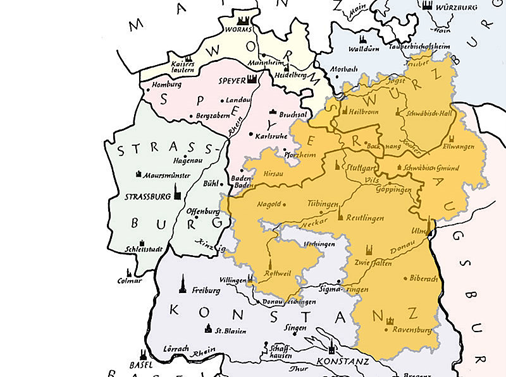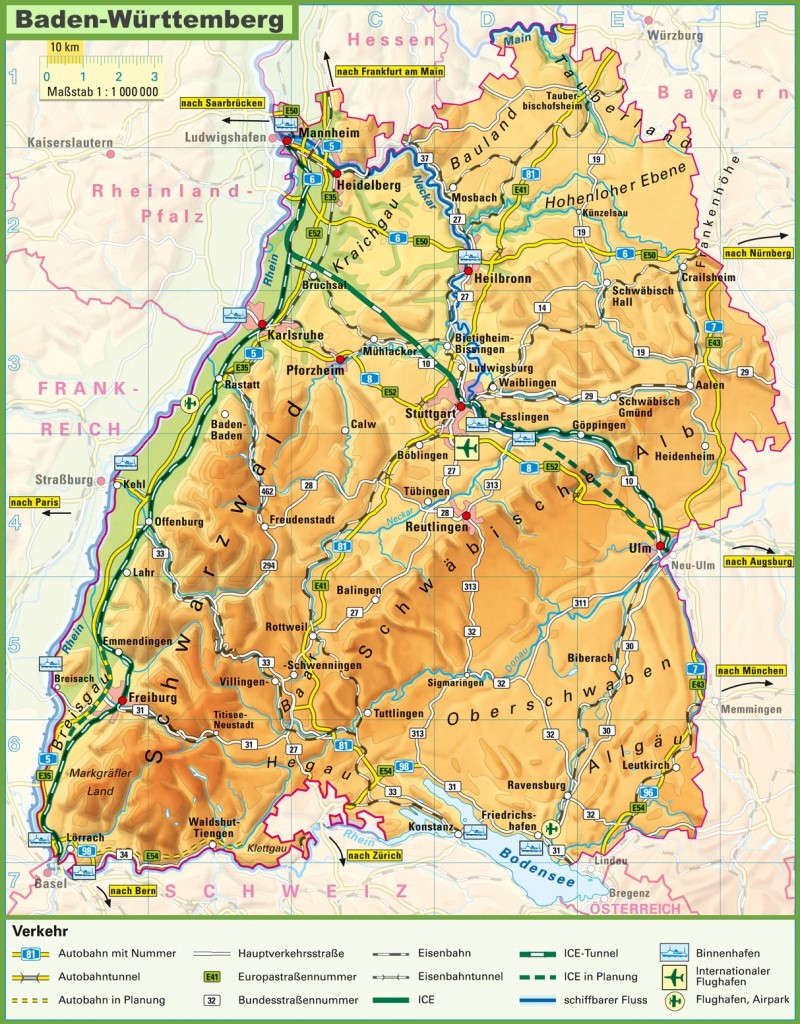Württemberg
I. Genealogical societies in Württemberg:
Verein für Familienkunde in Baden-Württemberg e. V.
Society for Family Research in Baden-Wuerttemberg


Verein für Genealogie in Nordwürttemberg e. V.
Society for Genealogy in North Wuerttemberg

https://genealogie-nordwuerttemberg.de/
DAGV # 69
The Society serves the region of Heilbronn – Franken in northern Württemberg. (Stadt- und Landkreis Heilbronn, Kraichgau und Hohenlohe)
Arbeitskreis Familien- und Ahnenforschung e.V.
Group for Family and Ancestor Research

http://www.afagev.de/
DAGV #78
The AFAG is a regional group for Geislingen an der Steige, Heidenheim, Ulm, Blaubeuren, Göppingen, and Schwäbische Gmund.
Forschergruppe Oberschwaben (FGO)
Researcher Group of Upper Schwabia

Forschergruppe Oberschwaben e.V. (forschergruppe-oberschwaben.de)
DAGV #85
This regional group serves the counties: Bodenseekreis, Kreis Ravensburg, Kreis Biberach and parts of the District Sigmaringen.

Forschergruppe Oberschwaben e.V. (forschergruppe-oberschwaben.de)
DAGV #85
This regional group serves the counties: Bodenseekreis, Kreis Ravensburg, Kreis Biberach and parts of the District Sigmaringen.
Arbeitskreis Donauschwaebisher Familienforscher e. V.
Danube Schwabian Family Researcher Group
DAGV #39
The AKdFF is devoted to the German settlements and settlers in the Banat, Batschka, Budapest, Ungarn, Schwäbische Turkei and others. The settlers were from Württemberg and other regions of southwest Germany, collectively named the Donauschwaben. The headquarters of this society is in the Haus der Donauschwaben, which was established after WWII in Sindelfingen, Württemberg.
The AKdFF is devoted to the German settlements and settlers in the Banat, Batschka, Budapest, Ungarn, Schwäbische Turkei and others. The settlers were from Württemberg and other regions of southwest Germany, collectively named the Donauschwaben. The headquarters of this society is in the Haus der Donauschwaben, which was established after WWII in Sindelfingen, Württemberg.
The above five societies are members of the Deutschen Arbeitsgemeinschaft Genealogischer Verbände (DAGV).
The DAGV accepts requests for research assistance. See:
German Association of Genealogical Associations V. (DAGV) - Inquiry point (www-dagv-org.translate.goog)
II. Archives of Württemberg
The Church Archives of Württemberg
A. The Protestant Church Archives of Württemberg
The church books of the Evangelische Landeskirche in Württemberg (Protestant State Church of Wuerttemberg) are available on Archion. www.archion.de. The books begin in many cases at the end of the 1600’s, and extend to about 1875. Archion is a subscription site sponsored by the Evangelische Kirche Deutschland (The Protestant Church of Germany). See: Price list - Archion
The Archiv der Evangelischen Landeskirche in Württemberg is located in Stuttgart – Möhringen. They possess the same records on microfilm. Landeskirchliches Archiv Stuttgart (elk-wue.de) Copies of these microfilms are also held by the Family History Library.
A listing of the Protestant Churches of Württemberg by Districts is here: https://www.archiv.elk-wue.de/fileadmin/mediapool/einrichtungen/E_archiv/Sonstige/Kirchenbuchdatenbank_LKA_Stuttgart.pdf
A listing of the Protestant Churches of Württemberg by Districts is here: https://www.archiv.elk-wue.de/fileadmin/mediapool/einrichtungen/E_archiv/Sonstige/Kirchenbuchdatenbank_LKA_Stuttgart.pdf
B. The Catholic Church Archives of Württemberg

The current Diocese of Rottenburg-Stuttgart imposed on the surrounding dioceses
Before 1828, the Catholics of Württemberg were members of the several dioceses in the map above. With secularization in the early 1800s, large Catholic areas and their Catholic residents were received by the Duchy of Württemberg, which soon became the Kingdom of Württemberg, both traditionally Protestant. The King of Württemberg demanded that a Catholic diocese be established for his state alone, in order to at least keep external bishops out of his state.
The Diocese of Rottenburg-Stuttgart website has a map that opens up to the parish level and its address: Der Diözesanatlas: Diözese Rottenburg Stuttgart (drs.de)
Family Search has records: Germany, Württemberg, Diocese of Rottenburg-Stuttgart, Catholic Church Records - FamilySearch Historical Records • FamilySearch
The State Archives of Württemberg
The Hauptstaatsarchiv (Main Archive) is located in Stuttgart.
Konrad-Adenauer-Straße 4
70173 Stuttgart
Hauptstaatsarchiv Stuttgart - Landesarchiv Baden-Württemberg (landesarchiv-bw.de)
Emigrant research is included here:
Auswanderung aus Südwestdeutschland (auswanderer-bw.de)
Emigration from Southwest-Germany (auswanderer-bw.de)
Other state archive locations are in Karlsruhe (Baden), Ludwigsburg, Freiburg, Sigmaringen, Wertheim and Neuenstein.
Emigration from Southwest-Germany (auswanderer-bw.de)
Other state archive locations are in Karlsruhe (Baden), Ludwigsburg, Freiburg, Sigmaringen, Wertheim and Neuenstein.
III. Other Genealogical websites for Württemberg
The portal of GenWiki for Württemberg: http://wiki-de.genealogy.net/Portal:W%C3%BCrttemberg
The Family Search portal for Württemberg: https://www.familysearch.org/wiki/en/W%C3%BCrttemberg,_German_Empire_Online_Genealogy_Records
Schwäbischer Heimatbund (schwaebischer-heimatbund.de) / The Schwaebian Homeland Association preserves and promotes the people, culture, natural features, and history of Schwabenland. Membership includes a glossy journal published quarterly. Many pictures.
The history and geography of Württemberg and Baden is presented by the Landeskundliche Informationssystem für Baden-Württemberg (LEO-BW): https://www.leo-bw.de/web/guest/home
IV. Printed Books and GGJ Articles on Württemberg
The GGS collection of Germanic Genealogy Books is located at the Minnesota Genealogy Center Mendota Heights, MN. The collection includes:
- Atlantic bridge to Germany: Baden-Württemberg v 1, Hall, Charles M.
- Emigrants from Eppingen to America in the eighteenth and nineteenth centuries, Burgert, Annette Kunselman
- German genealogical queries & research reports: pertaining to Baden-Wurttemberg and other Germanic regions: a 1990- 1991 project of the Pennsylvania Chapter of Palatines to America, Oertel, Burkhart
- Gesamtübersicht über die Bestände der staatlichen Archive Württemberg in planmässiger Einteilung / Overview of the State Archives of Württemberg Holdings and Their Subdivisions
- Grossgartach, Wuerttemberg, to Pennsylvania: some early Colonial German immigrants, Burgert, Annette Kunselman
- Guide to German parish registers: in the Family History Library of the Church of Jesus Christ of Latter-day Saints: Baden, Bavaria, Wuerttemberg, v 1
- Map guide to German parish registers: Kingdom of Württemberg I, Jagstkreis, v 5, Hansen, Kevan
- Map guide to German parish registers: Kingdom of Württemberg II, Neckarkreis & Hohenzollern Province, v 6, Hansen, Kevan
- Map guide to German parish registers: Kingdom of Württemberg III, Schwarzwaldkreis, v 7, Hansen, Kevan
- Map guide to German parish registers: Kingdom of Württemberg IV, Donaukreis, v 8, Hansen, Kevan
- Oberkochen: Geschichte Landschaft Alltag Oberkochen / Oberkochen: History, Countryside and Daily Life, Bantel, Dietrich Ed. (1986)
- Verzeichnis der Württembergischen Kirchenbücher / Register of Wuerttemberg Church Books, Duncker, Max. Dr. 1938
- Weischedel and related families from Feuerbach, Württemberg, Germany, 1550-1997: a genealogy, Dubel, Zelda Zeuge
- Württemberg emigration index, The, v.1 - 8
- Württemberg place name indexes: identifying place names using alphabetical and reverse alphabetical indexes, Minert, Roger P.
Check the Library for more information.
GGS Journal articles on Württemberg include:
- Winter 2004, 7:4:5, Turbes, Donna Hollerung, “A Guide to Resources for Württemberg”
- Summer 2014, 17:2:15, Riordan, Dan and Raiser, Willi, “Finding the Person Behind the Facts”
- Fall-Winter 2019, 22:3-4:34, Off, Christianne, “Visit to My Ancestral Village of Strümpfelbach, Württemberg”
- Fall-Winter 2020, 23:3-4:22, Kirner, Otto, “The Niethammer Family and Its Ancestral Home in Hausen an der Würm”
- Spring-Summer 2021, 24:1-2:5, Schmidt, Diane, “Johann Schmidt: A Case Study in Common Names”
V. History of Württemberg
Württemberg was a Grafshaft / County in 1099, part of the early Duchy of Swabia. Württemberg emerged as its own Duchy with its ruler Eberhard im Bart in 1495. The Reformation was embraced at the time of the infamous Duke Christoph. Württemberg remained a Duchy until the changes initially caused by the French (Napoleonic) wars of aggression resulted in the Duchy’s elevation to the Kingdom of Württemberg in 1805. It retained its independence from Prussia and its King until 1918.
After World War II, in 1952, Württemberg was merged with Baden to become Baden-Württemberg. The very small principality of Hohenzollern was added to the new state at this time.
Hohenzollern was the principality of the Counts of Zollern in 1061. They and their castle Hohenzollern, gave rise to two branches - the Catholic Swabian branch which remained here, and the Protestant branch which led to the rulers of Brandenburg and subsequently Prussia.
The castle Hohenzollern is off the main tourist route, but well worth a visit, partially for that reason. Information about the Hohenzollern dynasty:
http://www.britannica.com/EBchecked/topic/268949/Hohenzollern-dynasty
Der Württembergische Geschichts- und Altertumsverein e. V. / The Wuerttemberg Historical Association is located in Stuttgart. Startseite - Württembergischer Geschichts- und Altertumsverein e. V. (wgav.de)
After World War II, in 1952, Württemberg was merged with Baden to become Baden-Württemberg. The very small principality of Hohenzollern was added to the new state at this time.
Hohenzollern was the principality of the Counts of Zollern in 1061. They and their castle Hohenzollern, gave rise to two branches - the Catholic Swabian branch which remained here, and the Protestant branch which led to the rulers of Brandenburg and subsequently Prussia.
The castle Hohenzollern is off the main tourist route, but well worth a visit, partially for that reason. Information about the Hohenzollern dynasty:
http://www.britannica.com/EBchecked/topic/268949/Hohenzollern-dynasty
Der Württembergische Geschichts- und Altertumsverein e. V. / The Wuerttemberg Historical Association is located in Stuttgart. Startseite - Württembergischer Geschichts- und Altertumsverein e. V. (wgav.de)
VI. Maps

Topographical Map of today’s Baden-Württemberg
https://ontheworldmap.com/germany/state/baden-wurttemberg/large-detailed-map-of-baden-wurttemberg.jpg


Topographical Map of today’s Baden-Württemberg
https://ontheworldmap.com/germany/state/baden-wurttemberg/large-detailed-map-of-baden-wurttemberg.jpg

Württemberg in 1789
https://commons.wikimedia.org/wiki/File:WuerttembergPutzger1905.jpg
https://commons.wikimedia.org/wiki/File:WuerttembergPutzger1905.jpg

Württemberg and Baden from 1810 - 1945
By Ssch - Own work, CC BY-SA 3.0, https://commons.wikimedia.org/w/index.php?curid=350991
From 1815 to 1866, Württemberg was a member state of the German Confederation and from 1871 to 1918 it was a federal state in the German Empire.

Grenzen der Regierungsbezirke / Boundary Lines of the Governmental Districts (1952 – 1972)
bawue_1789.png (1775×2047) (landesarchiv-bw.de)
Following divisions into various Occupation Zones post-WW II, the current state of Baden-Württemberg was formed in 1952 by a merger of the historical Kingdom of Württemberg, the Grand Duchy of Baden and the former Prussian exclave of Hohenzollern.
